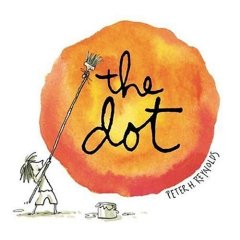
I wish that I could have the vanity of my 1st grade niece and the confidence of my pre-school niece, the swagger of my 3 year old niece and the giggles of my 2 year old nephew – but those days are long gone. Now I have the bluff of a cough-cough year old teacher!!
I “force” my writing workshop participants to write – and sometimes draw -because I believe that you can’t really teach writing unless you participate in it as well. But I realize, particularly when it is after a very long school day when a bazillion other things are on their minds and they are in front of their colleagues and out of their comfort zone, that coming up with something to write about is not as easy as it seems. And so it is for our students!
The book that (at least temporarily) gives me writing confidence is The Dot by Peter H. Reynolds, and even more the companion book Ish. First, The Dot!
Vashti struggles with in art class proclaiming “I just CAN’T draw!” Her inspirational teacher has her begin with “just a mark – and see where it takes you.” Before long – Vashti is the inspiration to a little boy who just “can’t” draw either. Along the way, Vashti experiments and finds her own “voice” in her work. The colorful artwork inspires the reader, while showing the real value of persistence and effort. I love this book and it inspires me to “make my own mark.” Imagine what sharing this thought to the struggling writer might do – to just make a sentence and see where it takes you. Or draw a picture and see what it inspires. To just put something down, feel free to experiment with words, play with them and make them your own – the liberation that writing can bring!! I love this book!! (Have I mentioned this already?)
And then came “Ish.” Quite the opposite of Vashti, Ramon looooves to draw. “Anytime. Anything. Anywhere.” (You’ll be amazed at the anywhere!) Then, as fate would have it, his confidence is crushed by his older brother who laughs at his drawing of a vase of flowers. After many months of trying and reams of crumpled paper, Ramon gives up. He’ll never draw the perfect vase of flowers. But his little sister has been collecting all the discards and created her own “crumpled” gallery. When Ramon protests that it doesn’t look like a vase of flowers, she replies “Well, it looks vase-ISH!” Ramon found his –ish; more drawings happened, even poems happened. This made me think about all the hullabaloo about cursive writing and penmanship. Does it matter whether a letter is formed perfectly? Is it acceptable to be just “legible” and not perfect? I value the creativity – the risk taking – of writing. As long as I can read it, the letters don’t need to be formed perfectly, it’s the word behind it that counts.
Think about these books as you work with aspiring (or inspiring) writers – how can we encourage writing and show them what really matters?
(Friday's post a little early - I have a superstitious streak!)
2 comments:
How to keep the balance between the draft and polish, there lies the rub. I do agree that to write with freedom is long lost with private journals and long letters to cherished friends. In those moments people practiced expression in a way that our young e-mailers never will experience outside of the language experience or writers workshop. We do need to spark that flame but at some point we need to bring them back to final copies and the precision needed to express yourself in a way that does not require a professional decipherer.
As I was reading what you wrote, I thought about the excitement and risk taking that kindergarteners have when they enter school. The pure joy they have on their face when they make that picture, those random letters to that first word. If we could only find the secret formula to bottle that and carry it with each child as they go through school. I agree with Dana, that many children will never foster that creativity for themselves because of the emails and chat rooms. Writing a simple letter to a friend is gone. It is easier to use the chat room with all its shorthand. We try to inspire our children with exemplar writing and books such as the one you commented on. But there are still those children we cannot seem to reach. I have truly found the power in read alouds and think alouds. Maybe as we move to doing more and more of this, it will help inspire those children to be more risk takers. Finding that balance as Dana put it is the key. But how do you find the right balance for each individual child?
Post a Comment